Are you a Quiet Speculation member?
If not, now is a perfect time to join up! Our powerful tools, breaking-news analysis, and exclusive Discord channel will make sure you stay up to date and ahead of the curve.
In my early experiments with delirium, I found Tarfire invaluable as a card that efficiently stocked the graveyard with card types. Its especially Modern-relevant effect soon made the card an obvious include in most of my Traverse the Ulvenwald brews. Another card I tried, Architects of Will, also guaranteed two types in the graveyard for a one-mana investment. But its inability to directly affect the board caused me to prematurely abandon Architects, favoring Mishra's Bauble in decks that wanted an artifact type. Today, the four-mana 3/3 gets a second chance.
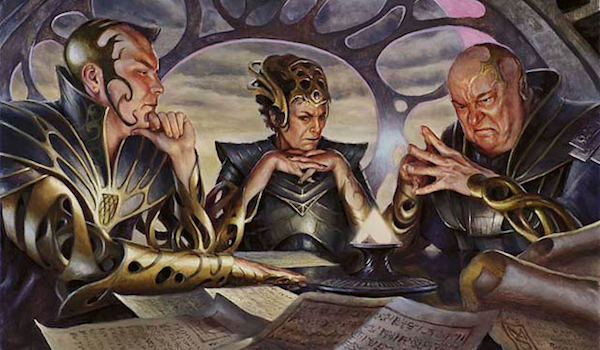
Is There a Doctor Architect In the House?
Tron, Ad Nauseam, Grishoalbrand, and other noninteractive archetypes rarely kill Noble Hierarch or Delver of Secrets, making it tough to acquire delirium when we're counting on a creature to hit the grave quickly. Jund and Jeskai are packed with removal, but it can prove difficult for delirium decks to place a creature in the graveyard against linear strategies, which skimp on removal to sharpen their own proactive gameplans. I had ignored this issue before, figuring that if Hierarch or Delver lived, my opponents would be dead before they could realize their synergies. 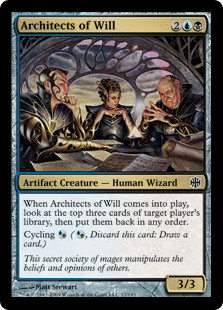 But the last couple weeks of testing have led me to miss that early delirium for matchups where sticking Magus of the Moon or finding a crucial Snapcaster Mage could mean life or death.
But the last couple weeks of testing have led me to miss that early delirium for matchups where sticking Magus of the Moon or finding a crucial Snapcaster Mage could mean life or death.
When Nexus reader Thorston K reminded me about Architects of Will in the comments of my article last week, I rushed to re-sleeve the homely Wizards. Inspired by the comments section as I was, the first shell I tried Architects in was Sultai Faeries. I experienced many of the problems I assumed I would with that shell: between 22 blue cards for early action in Disrupting Shoal (or red for a set of Lightning Bolts, which I didn't try but can't imagine ends very well---more on the necessity of Bolt, Path, or Shoal in interactive combat decks here), Architects for delirium, a bullet package (however small) for Traverse, and a couple of Mutavaults to buff Spellstutter Sprite, the deck had too much going on to stay focused and survive early or close later. The list I landed on ended up not running Architects at all, but I still wasn't convinced Traverse had much over Inquisition of Kozilek, Spell Snare, and more than one Tasigur.
[wp_ad_camp_1]
Architects in Sultai Tempo
I was looking to employ Architects of Will, so I put Spellstutter back on the bench and got back to tweaking German Thresh. With an incoming of one-mana cantrips that happened to be blue four-drops, my first order of business was to cut Lightning Bolt for Disrupting Shoal, which surprisingly wasn't too difficult. Four isn't exactly Modern's magic number (depending on your metric, of course), so I neglected to count Architects towards Shoal's 22 blue cards, giving us a total of 26. But hey, if Shoal happens to nab a Nahiri or a Scapeshift, I definitely won't complain.
Stubborn Sultai, by Jordan Boisvert
This Sultai Tempo deck adopts a similar philosophy to my Faeries build, but doubles down on proactivity with Grim Flayer and Tarmogoyf, counting on a full set of Stubborn Denials to protect its nasty beaters. The 8-Goyf approach can severely punish a Modern format increasingly low on Abrupt Decays, the only non-Verdict Goyf killer Stubborn doesn't handle.
Micro-Synergies
Besides neutering strong starts from blistering aggro and combo decks, Disrupting Shoal lets us tap out on turn two for a four-power threat before untapping with a grip full of Denials. My early testing with Grim Flayer showed me the power of his undervalued combat damage ability, which allows us to set up Stubborn Denial protection almost every turn in this deck. 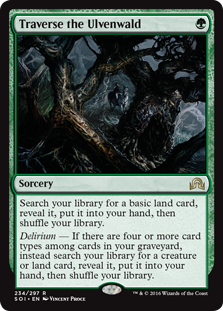 Between Denial, Snapcaster Mage for Denial, and Traverse for Snapcaster for Denial, most mid-games leave us with about ten functional copies of the instant in our deck. Flayer's "gravescry 3" effect lets us dump anything that doesn't keep us ahead, and following combat with a Serum Visions lets us dig seven cards deep to find adequate disruption for our opponent's next turn. Some context: that's a Dig Through Time's-worth of new cards seen.
Between Denial, Snapcaster Mage for Denial, and Traverse for Snapcaster for Denial, most mid-games leave us with about ten functional copies of the instant in our deck. Flayer's "gravescry 3" effect lets us dump anything that doesn't keep us ahead, and following combat with a Serum Visions lets us dig seven cards deep to find adequate disruption for our opponent's next turn. Some context: that's a Dig Through Time's-worth of new cards seen.
Scry also synergizes with cantrips. If we attack with Flayer and leave Stubborn Denial on top, we can cast Serum to have it on-hand for the next turn cycle in addition to setting up our next draw. Architects of Will might not scry, but it also cantrips into cards seen with Flayer or Visions.
Metagame Positioning
I've never been keen on Sultai in Modern because of its difficulty interacting with the format's faster decks. Both Sultai lists packed with nerfed interaction like Disfigure and "bigger" ones leaning on Thragtusk to recover later also struggled in the face of Modern's reigning midrange murderer, UrzaTron. Stubborn Sultai covers some ground in addressing both of these issues.
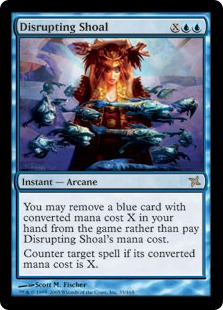 Disrupting Shoal shines against every linear Modern deck outside of big mana strategies like Tron and Valakut, but I've already discussed it at length elsewhere. It also fulfills a role similar to Lightning Bolt's in this deck. This section will instead focus on Stubborn Sultai's other methods of beating a Modern gauntlet.
Disrupting Shoal shines against every linear Modern deck outside of big mana strategies like Tron and Valakut, but I've already discussed it at length elsewhere. It also fulfills a role similar to Lightning Bolt's in this deck. This section will instead focus on Stubborn Sultai's other methods of beating a Modern gauntlet.
Against faster creature decks, beefy two-mana threats like Grim Flayer and Tarmogoyf pull a ton of weight by locking down the ground and becoming clocks after we dismantle an enemy's offensive. You'd be hard-pressed to find a Burn or Zoo player who likes facing down a Lhurgoyf, and since Architects turns on delirium so efficiently, Flayer functionally doubles our copies in these matchups.
Speedy spell-based decks could care less about our red-zone defense, but 4/4s still pressure them admirably. Some combo archetypes, like Storm, run Lightning Bolt to take care of pesky attackers while they set up; notably, that card doesn't do much against a bigger creature. But the real edge Stubborn Sultai has against spell-based linear strategies is its playset of namesake counterspells. Bring to Light, Through the Breach, and Chord of Calling are easy enough to nab with a non-ferocious Stubborn Denial, but having a cheap, easily recurrable hard-counter in the late-game gives us a distinct advantage over other blue decks against spell-powered linear strategies.
The immense flexibility of Tarmogoyf, Stubborn Denial, Disrupting Shoal, and Traverse the Ulvenwald give us plenty of game against other fair decks like Jund. But Stubborn Sultai's ability to turn the corner promptly, combined with its blueness, positions it better against big mana than its BGx cousins. 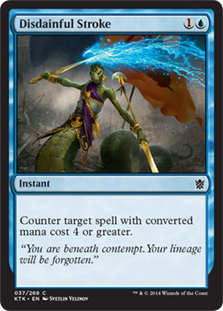 Denial and Mana Leak can usually handle Tron's payoff cards in time for Flayer, Goyf, and Snapcaster to squeeze in 20 points of damage, although we do miss Simic Charm sometimes against a resolved 6/6.
Denial and Mana Leak can usually handle Tron's payoff cards in time for Flayer, Goyf, and Snapcaster to squeeze in 20 points of damage, although we do miss Simic Charm sometimes against a resolved 6/6.
Disdainful Stroke surprises me daily and is becoming one of my go-to sideboard choices for blue decks in this format. It stops every threat in Tron, Valakut, and Scapeshift, as well as key cards in Jund, Jeskai, and many combo decks. Importantly, it counters spells even after Tron opponents deploy an additional Urza's Tower to dodge Mana Leak.
Our counter suite can also halt Tron's mana development, preventing it from ever hitting six mana in the first place. Disrupting Shoal shines during this phase of a game, hitting Expedition Map and Sylvan Scrying while we land Goyf or Flayer and set up a Leak/Denial stream with Serum, Snapcaster, Traverse, and Flayer's ability.
Architects in TarmoDrazi
I like big Goyfs and I cannot lie. This build of TarmoDrazi grows the Lhurgoyf to 6/7 at breakneck speed, using both Architects of Will and Tarfire to rapidly stock the graveyard. All that grave-buffing also gets us maximum mileage out of Traverse the Ulvenwald. If any deck can use a one-mana Sylvan Scrying/Eladamri's Call hybrid, it's the one packed with terrifying creatures and sol lands to cast them.
Temur Eldrazi, by Jordan Boisvert
Improving Traverse
TarmoDrazi games where I led by killing a creature with Tarfire, Traversing into Eldrazi Temple, and slamming a bunch of 5/5s were my best. But I sometimes struggled to turn on delirium early enough for Traverse to search up the Temple, reducing the sorcery to a late-game bomb and ridding it of earlier utility. This problem mainly arose against linear combo decks, since I lacked targets for Tarfire and would have to burn "nothing" to make a Sol Ring out of Traverse. The resulting Sylvan Scrying ended up costing me two cards; if I'd had a Tarfire in these matchups that simply cantripped, they would have gone much smoother.
Enter Architects of Will. With eight superb delirium enablers in Game 1, Traversing for early Temples becomes par for the course. Even without other card types, Tarfire and Architects combine to instantly turn on Traverse the Ulvenwald. My strategy with this deck has been to board out the less useful delirium enablers most of the time---against Tron, Ad Nauseam, Grishoalbrand, etc. Tarfire comes out, and against Zoo, Burn, Delver, etc. Architects comes out.
Filling Out the Disruption Slots
I sacrificed Lightning Bolt to fit four Tarfires, but so far, I haven't missed three damage much. Reshaper, Thought-Knot, and Tarmogoyf do a fine job against Nacatl decks, where Tarfire also happens to shine. The extra point on our Goyfs from tribal compensates in a damage race, although Bolt is usually preferable in these situations. Either way, I think the compromise of maxing out on Tarfire and abandoning Bolt is worth the consistency boost to Traverse in a deck that wants to find Eldrazi Temple so quickly.
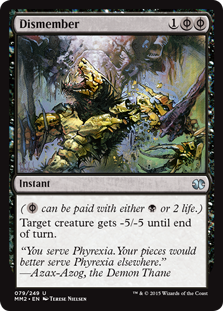 Four slots still needed filling. I started with a full set of Stubborn Denial, reasoning that if Traverse was live more often, I could dig up Temple or Thought-Knot reliably enough to fully benefit from a one-mana Negate. But some initial tests revealed that the deck wanted more ways to interact with creatures, especially ones that lived through Tarfire. TarmoDrazi needs to interact with opponents as it sets up its lands and hand with cantrips and search effects. If it can "start playing" at the same time as a lightly disrupted opponent, Thought-Knot and Smasher will trump Kitchen Finks and Lingering Souls any day of the week. Dismember was my go-to choice here, and it hasn't disappointed me yet. Even against aggro decks, Dismember usually loses us less life than a few hits from whatever threat they would have, and costing only one is a huge deal in a deck with so many cantrips.
Four slots still needed filling. I started with a full set of Stubborn Denial, reasoning that if Traverse was live more often, I could dig up Temple or Thought-Knot reliably enough to fully benefit from a one-mana Negate. But some initial tests revealed that the deck wanted more ways to interact with creatures, especially ones that lived through Tarfire. TarmoDrazi needs to interact with opponents as it sets up its lands and hand with cantrips and search effects. If it can "start playing" at the same time as a lightly disrupted opponent, Thought-Knot and Smasher will trump Kitchen Finks and Lingering Souls any day of the week. Dismember was my go-to choice here, and it hasn't disappointed me yet. Even against aggro decks, Dismember usually loses us less life than a few hits from whatever threat they would have, and costing only one is a huge deal in a deck with so many cantrips.
It's also possible that 1-4 Lightning Bolts would perform well in these slots, but I haven't tested them yet.
Metagame Positioning
Temur Eldrazi beats up on other midrange decks, since its creatures and kill spells are more mana-efficient, it plays far fewer lands, and it can search up bullets as needed. Stubborn Denial profitably stops problematic spells like Liliana of the Veil and Nahiri, the Harbinger, and Matter Reshaper provides a surprisingly relevant clock (especially with exalted) that punishes opponents for interacting.
Midrange mirrors are frequently toss-ups in Modern, and interactive opponents can still beat us. Opposing Tarmogoyfs can wall our attacks and keep us at bay as Liliana plusses up to a million. Dismember (usually used during combat) and the sideboard Engineered Explosives address this concern. The instant also kills Restoration Angel, a monster threat against us if opponents can contain our board.
 During Eldrazi Winter, I often joked (seriously) that Eldrazi was such a powerful deck because it ran 20 Tarmogoyfs.* Indeed, unhindered access to so many efficient threats did break the deck. While no Eye of Ugin slows us down a little, we still play those same creatures, and aggro decks like Zoo and Burn struggle immensely against a wall of 4/4s. These decks can come out from under us if we don't turn the corner aggressively, but we still enjoy positive matchups against Modern's swarms of linear aggro strategies. Our removal suite, buffered by Kozilek's Return from the sideboard, hassles synergy-based aggro decks like Chord, Affinity, Merfolk, and Elves.
During Eldrazi Winter, I often joked (seriously) that Eldrazi was such a powerful deck because it ran 20 Tarmogoyfs.* Indeed, unhindered access to so many efficient threats did break the deck. While no Eye of Ugin slows us down a little, we still play those same creatures, and aggro decks like Zoo and Burn struggle immensely against a wall of 4/4s. These decks can come out from under us if we don't turn the corner aggressively, but we still enjoy positive matchups against Modern's swarms of linear aggro strategies. Our removal suite, buffered by Kozilek's Return from the sideboard, hassles synergy-based aggro decks like Chord, Affinity, Merfolk, and Elves.
*Aside: People sometimes ask me if I think Tarmogoyf would be playable at three mana. That Eldrazi still puts up results despite Wizards's nerf last ban cycle indicates that it would.
Tron still annoys this deck, as it does most midrange archetypes. Thought-Knot, Denial, Smasher, and the searchable Magus of the Moon all help out here, but I've still posted a negative record versus the big mana menace.
Building a Better Traverse
Little is known about architects, a mysterious class of humans responsible for the design of most buildings (I think). Many sleepless nights of Googling have led me to the conclusion that they build things. In Modern, Architects of Will has historically been used to power Living End. But even architects must get promotions. I think the humble plotters have a bright future ahead of them: building delirious graveyards.





I’m loving the brewing.
Maybe I’m greedy, but I would love to see a list that combined the powers of Snapcaster, Lightning Bolt, Stubborn Denial, Traverse, and Grim Flayer. I don’t think it’s possible, however.
I like the idea of the faster clock with Reality Smasher and the Eldrazi splash, but why did you cut Oath of Nissa? Was it for Ancient Stirrings? My one problem with the new Temur Eldrazi list is that it really cannot kill opposing goyfs (other than dismember, which I am not a fan of). Liliana with Oath could certainly help that. Unless you functionally cut Liliana for Thought-Knot Seer which I can understand.
Have you tested a deck that runs Grim Flayer, Goyf, and TKS as the 12 threats?
Dismember and Explosives are there to kill Goyfs. It was hard to get Oath to pump delirium on-time (needed multiples); Architects is testing better in this kind of shell. Haven’t tested that kind of Flayer-Eldrazi list, I think it’s too greedy. Let me know if you build it.
Nice article Jordan! I like the different ideas you have here, but I wonder why you often go for (to my mind) excessively greedy manabases when you don’t need to. Here’s the Delirium list I’ve been playing around with (into which Architects of Will slotted beautifully):
Creatures:
3 Gnarlwood Dryad
4 Tarmogoyf
4 Grim Flayer
3 Scavenging Ooze
Instants:
4 Abrupt Decay
2 Dismember
Sorceries:
3 Inquisition of Kozilek
2 Thoughtseize
1 Collective Brutality
1 Maelstrom Pulse
Artifacts:
4 Architects of Will
Enchantments:
3 Phyrexian Arena
1 Sinister Concoction
Planeswalkers:
3 Liliana of the Veil
Lands:
4 Ghost Quarter
4 Verdant Catacombs
2 Polluted Delta
2 Misty Rainforest
4 Overgrown Tomb
1 Breeding Pool
2 Treetop Village
2 Swamp
1 Forest
IMO, moving to a smaller color scheme does wonders for letting you get access to more card types. This list has done surprisingly well in testing, despite my initial hesitation to run Phyrexian Arena. Choosing Arena gave me some additional coverage in mainboard Scoozes over mainboard Bobs, and moving to fewer Sinister Concoctions has also made my hand less reliant on the extra cards Bob/Arena provide overall. That decreased reliance has in turn mitigated the extra mana for Arena.
This delirium based rock list focuses on making an enormous goyf, which it can do with relative ease. The incidental benefits that accrue from delirium just add to the raw power of the list. The typical turn 1 discard spell into 3/4 goyf into liliana remains as viable as ever, but this variant opens up a broad variety of additional equally strong paths. Turn 1 fetch, dryad into turn 2 cycling architects and playing a sorcery nets you a 3/3 deathtouch nacatl for it’s first attack step while you end up ahead on cards.
Just a different idea to maximize goyf and delirium, but I’d be curious what faults you find with the concept, if any.
Thanks! Here are my initial thoughts on your list.
Gnarlwood Dryad – Do you often want a 3/3? I don’t like having a card in this shell that dies to Lightning Bolt during every stage of the game without necessarily providing additional value.
Scavenging Ooze – Great card, big fan. Seems especially potent in a midrangey shell like this one.
Targeted discard – Decent disruption, but I’ve still found it lacking against big mana, combo, and control. That’s one of the main reasons to be in blue: Stubborn Denial plugs a lot of holes here.
Phyrexian Arena – I think Arena is too expensive for what it does, and the life loss is a serious issue, too. I can maybe see this card as a one-of, but envision it being very clunky in multiples, even with Liliana and Brutality to dump extra copies. Snapcaster Mage is practically a strict upgrade IMO, and a singleton, searchable Tasigur also plays Arena’s role better than the enchantment since his body is so relevant and he comes down cheaply.
Sinister Concoction – I would rather have a third Dismember or some Nameless Inversions. Concoction seems like way too much of a minus to include, even though it stocks the ‘yard. We don’t need 7/8 Goyfs for this deck to work, we just need to hit delirium early and consistently to make sure Flayer and Traverse are on fast. Architects probably does enough in this regard.
Liliana of the Veil – Going in this direction pulls you into more of a midrange shell, which gives you points against the already-beatable fair decks at the cost of weakening your unfair matchups. I see this list struggling to beat Tron and Valakut, for example.
On the greedy manabase: I think yours is about as greedy as mine with the 4 Quarters and Treetops. I invariably design my manabases to fetch around Blood Moon very effectively, whether I’m playing the enchantment or not—that’s why you’ll frequently see me forego admittedly great cards like Creeping Tar Pit in my brews. Traverse makes it very hard to lose to the hoser, and since I think the blue adds so much to this deck in terms of metagame coverage, I wouldn’t recommend going straight GB.
One last thing—in the scenario you described with Dryad, sorcery, Architects, how exactly are you up on cards? Cycling doesn’t net any advantage, it just replaces cards from your hand while stocking the graveyard.
Hope this helps 8)
Very much so! Thanks for your input. My thoughts on the Gnarlwood were as follows: it trades with every card in the format at parity+ since it only costs 1, and if we can use it to trade with opposing creatures we can better use our targeted discard and removal to keep the pathway clear for a more aggressive stance using Flayers and Goyfs.
I see your points on Nameless Inversion over Sinister Concoction and the downsides of the Arena, so I’ll definitely be testing variants in these slots to see what, if anything, tends to work out best.
Best,
Chris
Have been testing GB delirium recently, architects may be interesting. Currently nameless inversion has been an all star, alongside commune with the gods and grisly salvage as graveyard fillers. Other notables include Ancient of the Equinox (who is amazing) and grim flayer/goyf. Included is 4 traverse to let us tutor what we need, and a pair of mindwrack demon and ishkanah grafwidow, although these seem high cmc, they can really come down and win the game, Ishkana can totally gum up the board so that attacks are incredibly difficult.
I like Architects AND Inversion to cover ground against more matchups, as with Temur Eldrazi in the article. If I didn’t need to maintain a high blue cad count for Shoal, I would probably run Inversion in my Sultai list. But I’m not a fan of Mindwrack and Grafwidow, who seem too vulnerable to catch-all removal spells to justify their expensive price tags. You could cut those, lower your curve, and splash red for Bolt and Magus, or splash blue like I did for Shoal and other permission. How do you fend off linear aggro decks? What’s your plan against decks like Ad Nauseam without relevant disruption i.e. Stubborn Denial? Finally, I would also expect you to clog on two-drops quite a bit with all those pricey setup cards. Architects will probably be quite the upgrade from Commune with the Gods in that respect.
How den es ancient equinox meqasure up against thrun the last troll?
Nameless Inversion is my fav enabler too as it basically is the missing Lightning Bolt in this deck. T1 Fetch + Serum/Probe
T2 Goyf/Grim
T3 Nameless = attack for 7+with Denial/Snap/Dispel mana up.
What about Spontaneous Mutation in place of Dismember? It wont kill the creature, but it will most likely stop it from dealing any more damage to you or your creatures. It can be played at instant speed, dodges dispel, costs no life, and feeds delirium worst-case.
Enemy Goyfs will still wall Smasher, TKS, Reshaper, etc., and I’m not sure we can count on it to hit the graveyard when we want it to. I’d rather have harder removal spells to deal with Goyfs and other threats. Dismember kills everything EXCEPT for Goyf without some combat damage to help out, and EE has a lot of utility against other threats, like a swarm of tokens or a Detention Sphere.
I just got mishras baubles, and now you blow us away with this common card! Bat investement from me, but good spottet from you
Aslo: Turn 1 fetchland, architect of will.
Turn 2 manamorphose into whispers of emrakul and you have a functional hymn to torach. You would also have a 4/5 goyf or a 4/4 grim flayer.
Unfortunatly it would involve a rather perfect draw even with 10 fetchlands in the deck. (I am picturing more of a jund deck then a delver deck.) But Thoughtscouer, Mishras Bauble, street wraight and gitaxian probe could help. You are esentially playing 12 goyf (goyf, grim flayer and traverse) in a deck that is closer to 40 cards then 60.
This might be sweet without Manamorphose. I like a card that actually does something there, instead, like IoK into turn three Hymn. Don’t worry about Bauble; it’s still a great delirium enabler and an underrated cantrip in this format IMO.
I’m curious if you think the ability of architects to turn delirium on faster/more consistently outweighs the ability of mishra’s bauble to “scry” 1 before you draw, while also being 0 mana. I can certainly see the advantage of the instant speed in more midrange style decks, but my instinct says that for tempo or aggro style decks bauble is preferable.
In the above decks, I do, which is why I’m playing Architects and not Bauble. Adding two types for delirium is really strong when you need to turn on Grim Flayer to have Denial live ASAP, or find Eldrazi Temple on turn two or three. But decks that can afford to hit delirium a little later and benefit from Bauble in other ways (i.e. Swiftspear decks) will still prefer Bauble.
Very interesting. It certainly looks like this is the path to making delirium work, but you look really weak to graveyard hate, particularly the first deck. Has this been a concern for you?
If you play delerium in modern, you are essentially auto including goyf because by the time you have delerium he is a 4/5. With grim and traverse you are playing 12 goyf by that time. Goyf has always been vil nerable to S. Ooze, relic of progenitus and rest in pice. You just have to accept it.
Stuborn denial, abrupt deckay and krosan grip can help midigate this.
Graveyard hate is something I’ve been keeping both eyes on since I started brewing with delirium. Rest in Peace is obviously the big killer against us, but it just doesn’t see that much play (somehow).
With Dredge on the rise, people are turning to Grafdigger’s Cage, which cuts off Snapcaster in the first deck and doesn’t do enough against either strategy above to make us worried.
I do run into Relic of Progenitus a lot online, and while it’s annoying, it’s still manageable. Usually opponents will need to crack it close to immediately to shrink an atatcking 6/7 Tarmogoyf, but thanks to cards like Architect and Tarfire, we can grow him right back up again. These decks are actually more resilient to graveyard hate than strategies hinging heavily on Bedlam Reveler, since Reveler asks us to have a critical mass of cards in the ‘yard. Delirium is fine with as little as two.
Hey Jordan! Are you currently brewing a sweet spirits deck for modern? Perhaps with Eldritch Moon, spirits will get a serious boost in power level. What do you think about spell quelcher in modern?
Queller is an easy include in Spirits. The ones I’ve messed around with have all played Tallowisp. Basically I’ve gone -4 Topplegeist, +4 Queller, +4 Mausoleum in the core and then filled out the rest of the shell in different ways. Check out this article for my take on Spirits, which hasn’t changed much with the new set despite running 8 new cards. https://quietspeculation.com/spirited-away-tribal-brewing-with-shadows-over-innistrad/
Have you thought about adding a copy of Sea Gate Wreckage in the Stubborn Sultai list? Yes, it makes your mana base a little bit worse, but it could be worth it. Disrupting Shoal is inherent card disadvantage, and it seems that list heads into top deck mode very quickly in any grindy game since you currently have one card in the 75 that puts you up on cards.
1) Running utility lands in a Sultai deck is a great way to lose to Blood Moon.
2) Card advantage is overrated in Modern; the tempo boosts Shoal can provide are often game-winning in this kind of deck. More: https://quietspeculation.com/tempo-modern-card-advantage-trap/
3) We spend all our mana and are frequently light on lands (not uncommon to have only 3 in play, especially in Game 1)
4) Stubborn Sultai doesn’t have any colorless-producing sources!
I’ve done some quick testing with the sultai deck, about 10 games. Won 8 of them vs various kinds of decks.
I lost 2-1 vs infect. That deck seems really tough to beat with this deck. Especially Inkmoth Nexus is almost impossible to get rid of. I think I’d prefer dismember over go for the throat in the board to give you at least some chance. I think I’d slide in some fulminators as well.
Second deck I lost to: RG Tron. First game he has natural tron (I countered a map and sylvan scrying) and a hand full of gas. Second game I can keep him off tron for a long time but he gets to resolve an oblivion stone while I have a disdainful stroke, sweep away my one creature and I never find another one. I can definitely see how we can win vs tron but this deck is very swingy with its opening hands as well.
I didn’t like the tasigur. You don’t want to delve away delirium so he often just sat in my hand untill the game was already won. But I don’t know what should be in its place.
All in all the deck is very fun, but it definately needs some tweaking. Especially manlands are a big problem IMO.
Thanks for the mini-report. Natural State, IoK, GftT, and Darkblast should help against Infect out of the side, and Shoal pulls a lot of weight in Game 1. I only got to play one match against them but I won it 2-0, though I did open Shoal both games. It’s still possible Stubborn Sultai in fact has a bad matchup against Infect, in which case it definitely needs tweaks to address that weakness.
Tron is a bad matchup. We fare better against them than most midrange decks in the format, but there’s only so much a threat-light, reach-free interactive strategy can do against those guys. Fulminator is an option but I’m not sure spending three mana on a sorcery-speed spell is exactly what we want to be doing in this deck. More Strokes might be better against Tron. Fulminator hitting manlands is a big draw though.
Dismember is one of my favorite cards but I’m worried about life loss in this deck. The idea behind Tasigur was that we could Traverse for him to have a one-card way to close out stalling games. For the record I haven’t liked him much either.
I’ve moved on to other brews for now (Sultai decks are like kinky diversions for me) but let me know how everything goes if you stay with the deck!